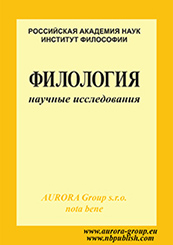Psycholinguistics
Reference:
Gorchakova, O.Y., Larionova, A.V., Aleksandrova, Y.K., Petrov, E.Y. (2021). The peculiarities of sociopolitical news discourse on the example of regional news public pages in the social network VKontakte . Philology: scientific researches, 3, 1–17. https://doi.org/10.7256/2454-0749.2021.3.35234
Abstract:
The subject of this research is the news content of public pages in the social network VKontakte. The goal consists in examination of peculiarities of organization of the regional news discourse, comparison of Tomsk and Novosibirsk news public pages. For achieving the set goal, the article employs the methods of qualitative (manual coding and machine learning) and quantitative data processing (content analysis, thematic analysis, psycholinguistic analysis). The empirical material contains regional news reports on sociopolitical topics, available for public viewing in the social network VKontakte (Tomsk and Novosibirsk). Analysis is conducted on the 3,786 postings in Novosibirsk and 887 postings in Tomsk. The author determines peculiarities and differences of media consumption depending on the region. It is noted that the federal news enjoy greater popularity among the users of the social network VKontakte; Tomsk residents are more concerned with the news reports covering regional events. The article reveals the specifics of creating news content characterized by the tendency towards narrativization of the news discourse. The prevalent narrative strategy of the media authors of regional news public pages consists in factual interpretation of the material with responses of high-ranking officials, authorized representatives of various structures, as well as regular persons (their opinions and attitudes, value judgments).
Keywords:
thematic analysis, content analysis, Vkontakte, regional news media discourse, news content, news discourse, social media, social networks, machine learning, Internet
Linguistics
Reference:
Kameneva, N.A. (2021). Formation of the English-language neologisms as a result of lexical and semantic nominations . Philology: scientific researches, 3, 18–26. https://doi.org/10.7256/2454-0749.2021.3.34854
Abstract:
This article is dedicated to the formation of English-language neologisms as a result of lexical and semantic nomination. The object of this research is the changes in the lexical system of modern English language based on the analysis of media and online publications. The subject of this research is the methods of formation of neologisms in the late XX and early XXI centuries. The author determines the most common methods of the formation neologisms in digital periodicals, online news websites, forums and blogs. Analysis is conducted on such methods of word formation as affixation, conversion, formation of complex words, shortening and hybridization, abbreviation, etc. It is noted that the majority of neologisms result from lexical nomination. The goal of this article lies in analysis of the formation of neologisms used in the English lexicon for a long period of time, and thus have acquired a certain official standing. Such lexical innovations have been included or are in the process of being included into the official English language. An attempt is made to reveal the key features of methods of formation of neologisms, which are of primary importance for the communicative and social activity in their broadest sense. Majority of neologisms in the language, which is over 70%, result from the lexical methods of word formation; while the share of neologisms formed via semantic derivation is only a few percent of the total number of lexical innovations.
Keywords:
Internet communications, mass media, clipping, compound words, conversion, affixation, diachronism, lexeme, semantic derivation, blending
Linguistics
Reference:
Krasnova, V.Y. (2021). Explication of axiological component of the Japanese folkloreme Issun-bōshi in the English versions of eponymous fairy tale . Philology: scientific researches, 3, 27–37. https://doi.org/10.7256/2454-0749.2021.3.35242
Abstract:
The subject of this research is actualization of the value component of Japanese culture on the periphery of the original Japanese folkloreme “Issun-bōshi” in the nine English-language versions of eponymous fairy tale. The article examines the methods of verbal explication on the discourse level through the dialogues, descriptions, and events of the original Japanese fairy tale and its English interpretations. The author determines seven axiological characteristics of the Japanese folkloreme, such as acceptance, dependence, modesty, service, etc. It is demonstrated how depending on the dialogues and descriptions in different versions of the Japanese folk tale, the value orientations of Japanese culture are explicated inalterably or adjusted to the perceptions of the author of English version. The conducted research reveals the specificity of one culture through another language and culture, as well as variability of presentation of the value orientations, attitudes, and preferences through the prism of mentality and values of the author of the foreign-language version. The following axiological components of Japanese folkloreme were determined: designated environment; love and acceptance; service to the emperor; family ties; modesty; spiritual beauty; and the folkloreme of magic gavel. The author carries out a comparative analysis of explication of the Japanese folkloreme in different English versions of the fairy tale; reveals the axiological components explicated in the text of Issun-bōshi and the differences in value orientations described in the English versions of the fairy tale.
Keywords:
folklorema periphery, value concept, folktale, verbalization, folklorema core, actualization, explication, folklorema, folklore discourse, cultural values
Rhetoric
Reference:
Ezhkova, V.A. (2021). The category of modality in rhetoric . Philology: scientific researches, 3, 38–47. https://doi.org/10.7256/2454-0749.2021.3.33413
Abstract:
This article examines the category of modality and its role within the structure of a persuasive text based on the research materials of the experts in the theory of argumentation (S. Toulmin, C. Perelman, L. Olbrechts-Tyteca) and scholars of rhetoric (Y. V. Rozhdestvensky, A. A. Volkov). The theory of argumentation observes two concepts of modality: according to one, modality is an integral part of the argument, according to the other – a way to express thoughts emphasizing the point of statement. The author draws parallel between the views of other researchers and the own definition of modality, which indicates the status of a sentence in relation to reality/unreality (semantic modality) or express an illocutionary function of the statement (pragmatic modality). The article provides a representation of modality not only within the framework of the theory of argumentation, but also rhetoric as a whole. The points of intersection are traced between the views of the experts in theory of argumentation and the scholars of rhetoric. The hypothesis is advances that in oratorical prose, modality alongside other modus categories, contributes to the expression of two rhetorical goals: to convince the addressee of their views (evaluation) and to convince the addressee to act by necessity (prescription). It is concluded that rhetoric broadens the understanding of modality in science and provides instruments for analyzing the role and place of modality in a persuasive text.
Keywords:
pragmatic modality, semantic modality, modality, argument model, oratorical prose, argumentation theory, rhetoric, possibility, necessity, modus
Linguistics
Reference:
Shigurov, V.V. (2021). Characteristics of the degrees of modalation and predicativation of word forms such as “it is evident” in asyndetic complex sentence . Philology: scientific researches, 3, 48–58. https://doi.org/10.7256/2454-0749.2021.3.34219
Abstract:
This article examines the mechanism of transposition of linguistic units from short adjectives into introductory-modal units and predicatives. The object of this research is word forms such as “it is evident”, which in asyndetic complex sentences represent a zone of hybrid structures on the scale of modalation. The subject of this research is the combinatorics and proportion of the characteristics of adjectives, introductory-modal words and expressions, and impersonal-predicative words (predicatives) within the structure of hybrids. The relevance of this work is substantiated by the need for studying the mechanism of interaction between grammatical and lexical within the structure of word forms involved in one or more transpositional processes on the level of parts of speech and inter-part-of-speech categories. On thee example of deadjectival word form “it is evident”, the author calculates the indexes of modalation and predicativation of short adjectives in the zone of hybrid structures represented by asyndetic complex sentences with explicative relations between the predicative parts. It is established that the hybrid “it is evident” demonstrates 56 % correspondence of differential characteristics with characteristics of the original nuclear short adjective “evident” in the meaning of “available for visible perception”, 27 % correspondence with the characteristics of nuclear introductory- modal word “evident” in the meaning of “probably”, and 67% correspondence with the characteristics of nuclear predicative “it’s a shame” with the semantics of emotional state of a person and moral-ethical evaluation of his behavior.
Keywords:
introductory modal word, short adjective, predication, modalation, transposition, grammar, Russian language, predicative, hybrid, indexing
Discourse
Reference:
Seregina, M.A. (2021). Tourism discourse: linguosemiotic peculiarities of functionality of paremias . Philology: scientific researches, 3, 59–66. https://doi.org/10.7256/2454-0749.2021.3.33475
Abstract:
The subject of this article is the determination and analysis of linguosemiotic peculiarities of functionality of phraseological units of syntactic level in the tourism discourse. The object of this article is the Russian and German paroemias as a hyperonym in relation to proverbs, proverbial expressions and sententious sayings. These set phrases have grammatical structure of the sentence and are used in the literal and figurative sense. The goal of this research is to determine and analyze the semantic, syntactic and pragmatic peculiarities of implementation of paroemias in guidebooks and brochures in the Russian and German languages, which demonstrate ethnocultural specificity of the peoples. The author employs interdisciplinary approach, which is substantiated by active use of the scientific category “tourism discourse" in different sciences. The main conclusion consists in the presence of linguosemiotic peculiarities of the functionality of paremias in guidebooks and brochures. Using the analysis of lexical-semantic structure of the Russian and German paremias, the author determines the semantic dominants of paremiological representation of the concepts of tourism discourse in the Russian and German linguocultures that contain ethnocultural stereotypical representations of the peoples on traveling; and this defines the author’s special contribution. The novelty lies in proving fact that the functionality of paremias in the language of guidebooks and brochures has syntactic peculiarities that are revealed in their integration into the context for cohesiveness of the tourism discourse. Pragmatic peculiarities are determined by the choice of strategies and tactics aimed at drawing attention of the tourists and increasing interest in the services rendered.
Keywords:
national and cultural specifics, functioning, lingvo-semiotic features, German paremias, guidebooks and avenues, tourist discourse, Russian paremias, proverbs, proverbial sayings, sayings
 This work is licensed under a Creative Commons Attribution-NonCommercial 4.0 International License.
This work is licensed under a Creative Commons Attribution-NonCommercial 4.0 International License.











 © 1998 – 2025 Nota Bene. Publishing Technologies. NB-Media Ltd.
© 1998 – 2025 Nota Bene. Publishing Technologies. NB-Media Ltd.




